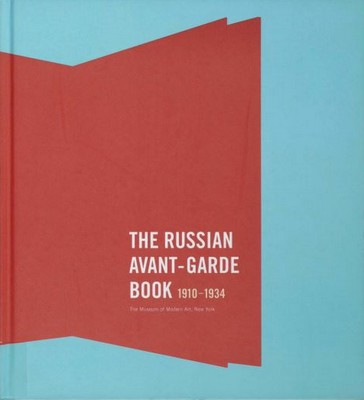The Russian Avant-Garde Book: 1910–1934
MoMA, New York
March 21 - May 21, 2002
The Russian Avant-Garde Book, 1910–1934 is prompted by an extraordinary gift to MoMA of over 1,000 Russian avant-garde illustrated books from The Judith Rothschild Foundation, New York. The gift is the largest to the Department of Prints and Illustrated Books since Abby Aldrich Rockefeller established the collection in the 1940s with her donation of 1,600 prints. The Rothschild gift represents all the significant artistic developments of the period and features works by major artists including Kazimir Malevich, Olga Rozanova, Natalia Goncharova, El Lissitzky, Aleksandr Rodchenko, and many others. It also encompasses areas of special interest to members of the Russian avant-garde, including children’s books and Judaica. This comprehensive resource has been characterized by experts in the field as among the most significant collections of its kind worldwide.
The Rothschild gift joins over 400 works from the Russian avant-garde period already in the Museum’s collections of painting and sculpture, drawings, photography, film, architecture and design, prints and illustrated books, as well as the library. MoMA’s founding director, Alfred H. Barr, Jr., initiated the Museum’s interest in this crucial period in the history of modern art.
It is widely recognized that Russian avant-garde artists’ experimentation was fundamental to the development of abstraction in the early years of this century. The 1917 Revolution brought about a complete transformation of the artist’s role in Russian society with utilitarianism defining the new cultural climate. The exhibition is organized around three major themes:
A Slap in the Face of Public Taste
The first section is titled after an early manifesto by artists and poets, in which they responded to what they considered the stultifying conventions of academic taste and bourgeois sensibility. Natalia Goncharova, Mikhail Larionov, Olga Rozanova, Kazimir Malevich, among others, collaborated with writers and poets, including Aleksei Kruchenykh, Velimir Khlebnikov, and Vasilii Kamenskii, to forge a new language of abstraction through experimentation with Cubo-Futurism, Primitivism, and Rayonism. Many of these poets and painters practiced both mediums, and most were friends, siblings, or spouses; collaboration on books was one important result of this creative ferment. Early books were intended to shock the reader with variously sized pages made of coarse papers, illustrations entwined with printed, hand-written, and rubber-stamped text, as well as provocative covers.
Transform the World!
The second section expands on the developments of the earlier period. Artists turned to book design with great optimism to reach the masses. In both paintings and printed treatises, Malevich pushed abstraction to its limit in his development of Suprematism, conceived as a metaphysical visual metaphor for heralding the new world. Aleksandr Rodchenko and El Lissitzky were major artistic voices in the development of Constructivism, which focused on the rational and machine-made and came to symbolize a new future. Typography became an important aspect of Constructivism, often combined with bold black and red abstract designs. Poets such as Vladimir Mayakovsky, who was also an artist, played an integral role in the interdisciplinary development of illustrated books during this period. Photography was also a primary vehicle of communication, and photomontage dominated many covers and illustrations.
Building Socialism: Agitation Art
The final section of the exhibition presents the variety of ways the art of the book was used to serve the Soviet government’s agenda. Journals showcased modern Soviet architecture with covers of bold graphic design. Trade catalogues promoted Soviet industry with innovative layouts and typographical design. Magazines designed by avant-garde artists utilized photography and photomontage to spread the message of Soviet modernization and progress to the broadest possible audience. Innovative works by Lissitzky and Rodchenko, as well as by other artists including Varvara Stepanova, Solomon Telingater, Gustav Klutsis and the Stenberg brothers, demonstrate a continued experimentation with the book format. The exhibition ends with the notorious 1934 decree by Stalin that only Socialist Realism would be tolerated. Thus, a remarkable period of innovation in the production of illustrated books came to a close.
Catalogue
Catalogue of the exhibition
© The Museum of Modern Art
A major publication illustrating all the books in the exhibition accompanies the exhibition. In addition to over 600 illustrations, the catalogue contains essays by the co-curators and other specialists: Jared Ash, Nina Gurianova, and Gerald Janecek. These includes an overview of the Russian avant-garde book in the context of the history of modern illustrated books; studies of the book both before and after the 1917 Revolution; and texts on specific stylistic and literary issues. The documentary portion of the book includes a complete checklist of all the books in the gift from The Judith Rothschild Foundation. There is also be a comprehensive bibliography and index.
The exhibition is organized by Deborah Wye, Chief Curator of Prints and Illustrated Books, The Museum of Modern Art, and Margit Rowell, Guest Curator.
The Russian Avant-Garde Book, 1910–1934 travels to the Museo Nacional Centra de Arte Reina Sofia, Madrid, November 4, 2002-January 27, 2003; and the Museum fur Angewandte Kunst, Frankfurt am Main, September 24, 2003-January 25, 2004.
MoMA - MUSEUM OF MODERN ART, NYC
Updated 16.01.2021

